Revenue Up 25% and Gross Profit Up 36% Year-Over-Year; Free Cash Flow Positive for Fourth Consecutive Quarter, Reaching 16% of Revenue
Internet, Everywhere – November 2, 2023 – Shopify Inc. (NYSE, TSX: SHOP), a provider of essential internet infrastructure for commerce, today announced financial results for the quarter ended September 30, 2023.
“Our third-quarter results demonstrate the progress we are making to further solidify Shopify’s position as the global leader in commerce,” said Harley Finkelstein, President of Shopify. “Our ability to help our merchants succeed in any economic environment by delivering innovative product solutions, has not only built strong trust with our merchants but has positioned Shopify for sustained growth and profitability for the future. As we look forward to the busiest shopping season of the year, we’re confident that our unified commerce platform empowers our merchants with the tools they need to seize every opportunity and achieve greater success.”
“We’re extremely pleased with our financial performance this quarter, which is a testament to the resilience and adaptability of our platform and our merchants,” said Jeff Hoffmeister, Chief Financial Officer of Shopify. “Our results showcased the durability of our business model as we delivered a compelling combination of both top line growth and profitability, with revenue growing 25% year over year and free cash flow margin reaching 16%. We will continue to operate with discipline, thoughtfully investing in the huge opportunities ahead across regions, products, and channels to help merchants capture every opportunity every step of the way.”
Recent Business Highlights
- Launched the Retail Plan, a new pricing plan for brick-and-mortar businesses selling primarily in-person that includes all Shopify POS Pro features as well as tools to build a simple online presence.
- Expanded availability of Shopify’s all-in-one mobile point-of-sale system, POS Go, to the U.K. and Ireland.
- Released in the U.S. and Canada, new enterprise-grade payments hardware, POS Terminal, which combines POS Go and the all-new POS Go Dock to give merchants the option to turn their mobile point-of-sale system into a WiFi and ethernet-connected reliable countertop payment device.
- Expanded our end-to-end cross-border commerce solution with native merchant of record offering, Shopify Markets Pro, to general availability in the U.S. in the third quarter.
- Optimized Shopify Checkout for conversion and speed by redesigning the checkout to a streamlined one-page checkout experience.
- Finalized commercial agreement with Flexport, to extend the partnership between Shopify and Flexport.
- Announced an app integration that allows U.S. merchants using Amazon’s fulfillment network the option to add the Buy with Prime app from our app ecosystem into Shopify Checkout with transactions processed through Shopify Payments.
- Partnered with Faire to continue to build out our business-to-business commerce offerings for our merchants, as well as create additional on-ramps onto Shopify as Faire’s preferred point-of-sale provider for their independent retail community.
- Announced a global partnership with WPP to jointly develop products and pair WPP’s commerce expert network with our platform to help brands scale faster and reach more customers.
- Recognized as a leader in the 2023 Gartner® Magic Quadrant™ for Digital Commerce and placed highest in the ability to execute, further exemplifying Shopify’s culture of innovation and unique vision for commerce.
Third-Quarter Financial Highlights
- Gross Merchandise Volume1 (“GMV”) increased 22% to $56.2 billion, an increase of $10.0 billion over the third quarter of 2022.
- Total revenue increased 25% to $1.7 billion compared to the prior year, which translates into year-over-year growth of 30%, after adjusting for the approximately 500 basis points impact from the sales of our logistics businesses.
- Merchant Solutions revenue increased 24% to $1.2 billion compared to the prior year, driven primarily by the growth of GMV and Shopify Payments.
- Gross Payments Volume2 (“GPV”) grew to $32.8 billion, representing 58% of GMV processed in the quarter, versus $25.0 billion, or 54%, for the third quarter of 2022.
- Subscription Solutions revenue increased 29% to $486 million compared to the prior year, driven primarily by more merchants joining the platform and the pricing changes that went into effect for existing merchants on our Standard subscription plans.
- Monthly Recurring Revenue3 (“MRR”) as of September 30, 2023 increased 32% to $141 million compared to the prior year, driven by continued growth across all of our subscription plans. Shopify Plus contributed $44 million, or 31%, of MRR compared with 33% of MRR as of September 30, 2022.
- Gross profit grew 36% to $901 million, compared to the prior year. Gross margin for the quarter was 52.6% compared to 48.5% in the third quarter of 2022, driven primarily from lapping the dilutive impact of the logistics business in the prior year.
- Operating income was $122 million, or 7% of revenue, compared to an operating loss of $346 million, or 25% of revenue, for the comparable period a year ago, driven primarily by higher gross profit and lower operating expenses in the quarter.
- Free Cash Flow was $276 million, or free cash flow margin4 of 16%, compared with negative free cash flow of $148 million, or negative free cash flow margin of 11%, in the third quarter of 2022.
- Cash and marketable securities were $4.9 billion as of September 30, 2023, and we had a net cash position of $4.0 billion after consideration of our outstanding convertible notes.
2023 Outlook
The outlook that follows supersedes all prior financial outlook statements made by Shopify, constitutes forward-looking information within the meaning of applicable securities laws, and is based on a number of assumptions and subject to a number of risks. Actual results could vary materially as a result of numerous factors, including certain risk factors, many of which are beyond Shopify’s control. Please see “Forward-looking Statements” below for more information.
Note that year-over-year comparability in our financial outlook will be impacted by the sales of our logistics businesses, which we expect will create a revenue growth headwind of approximately 400 to 500 basis points and a gross margin tailwind of approximately 300 to 400 basis points when compared to the fourth quarter of 2022.
For the remainder of 2023, we expect:
- Full year revenue to grow at a mid-twenties percentage rate on a year-over-year basis, driven by fourth quarter revenue growth in the high-teens year over year, which translates into a year-over-year growth rate in the low-to-mid-twenties when excluding the 400 to 500 basis points impact from the sales of our logistics businesses. As a reminder, for purposes of year-over-year comparability, the fourth quarter of 2022 was our strongest quarter of growth in the prior year;
- Fourth quarter gross margin percentage to be 300 to 400 basis points higher than the fourth quarter of 2022 gross margin of 46.0%, primarily due to the absence of the logistics business. Q4 gross margin will be down from Q3 2023, as has historically been the case, as Payments revenue will be a larger percentage of overall revenue due to the seasonality of the holiday selling season;
- Fourth quarter operating expense dollars to be down by a low-single-digit percentage rate compared to Q3 2023 operating expense dollars;
- Fourth quarter stock-based compensation to be approximately $100 million;
- Capital expenditures5 of approximately $45 million for the full year, inclusive of $33 million in the first half of the year related to logistics, and
- Fourth quarter free cash flow as a percentage of revenue to be in the high-teens. Free cash flow margin and free cash flow dollars have both improved every quarter this year, and Q4 will continue to deliver on this upwards trend – a clear manifestation of the steps that we have taken this year to drive towards greater profitability, as we build for the long term.
Quarterly Conference Call
Shopify’s management team will hold a conference call to discuss our third-quarter results today, November 2, 2023, at 8:30 a.m. ET. The conference call will be webcast on the investor relations section of Shopify’s website at https://investors.shopify.com/news-and-events/. An archived replay of the webcast will be available following the conclusion of the call.
Shopify’s Third Quarter 2023 Interim Unaudited Condensed Consolidated Financial Statements and Notes and its Third Quarter 2023 Management’s Discussion and Analysis will be available on Shopify’s website at www.shopify.com and will be filed on SEDAR at www.sedarplus.ca and on EDGAR at www.sec.gov.
About Shopify
Shopify is the leading global commerce company that provides essential internet infrastructure for commerce, offering trusted tools to start, scale, market, and run a retail business of any size. Shopify makes commerce better for everyone with a platform and services that are engineered for speed, customization, reliability, and security, while delivering a better shopping experience for consumers online, in store and everywhere in between. Shopify powers millions of businesses in more than 175 countries and is trusted by brands such as Mattel, Gymshark, Heinz, FTD, Netflix, Kylie Cosmetics, SKIMS, Supreme, and many more. For more information, visit www.shopify.com.
Forward-looking Statements
This press release contains certain forward-looking statements within the meaning of applicable securities laws, including statements related to Shopify’s planned business initiatives and operations and outlook, the performance of Shopify’s merchants, the impact of Shopify’s business on its merchants and other entrepreneurs, and economic activity and consumer spending. Words such as “continue”, “will”, “intend”, “could”, “believe” and “expect” or similar expressions are intended to identify forward-looking statements.
These forward-looking statements are based on Shopify’s current projections and expectations about future events and financial trends that management believes might affect its financial condition, results of operations, business strategy and financial needs, and on certain assumptions and analysis made by Shopify in light of the experience and perception of historical trends, current conditions and expected future developments and other factors management believes are appropriate. These projections, expectations, assumptions and analyses are subject to known and unknown risks, uncertainties, assumptions and other factors that could cause actual results, performance, events and achievements to differ materially from those anticipated in these forward-looking statements. Although Shopify believes that the assumptions underlying these forward-looking statements are reasonable, they may prove to be incorrect, and readers cannot be assured that actual results will be consistent with these forward-looking statements. Actual results could differ materially from those projected in the forward-looking statements as a result of numerous factors, including certain risk factors, many of which are beyond Shopify’s control, including but not limited to: sustaining our rapid growth; managing our growth; our potential inability to compete successfully against current and future competitors; the security of personal information we store relating to merchants and their consumers, as well as consumers with whom we have a direct relationship including users of our apps; a denial of service attack or security breach; our ability to innovate; our limited operating history in new and developing markets and geographic regions; international sales and operations and the use of our platform in various countries; our current reliance on two suppliers to provide the technology we offer through Shopify Payments; the reliance of our business, including the services we provide to merchants, in part on the success of our strategic relationships with third parties; our potential inability to hire, retain and motivate qualified personnel; our use of third-party cloud providers to deliver our platform services; complex and changing laws and regulations worldwide; our dependence on the continued services of our senior management and other key employees; payments processed through Shopify Payments, Shop Pay Installments, or payments processed or funds managed through Shopify Balance; our potential failure to effectively maintain, promote and enhance our brand; our ability to maintain profitability; serious errors or defects in our software or hardware; our potential inability to achieve or maintain data transmission capacity; activities of merchants or partners or the content of merchants’ shops and our ability to detect and address unauthorized activity on our platform; evolving privacy laws and regulations, cross-border data transfer restrictions, data localization requirements and other domestic or foreign regulations that may limit the use and adoption of our services; the impact of acquisitions, divestitures, investments, or other significant transactions including fluctuations in our share of income and loss from equity investments accounted for under the equity method; risks associated with Shopify Capital, and offering financing to merchants; potential claims by third parties of intellectual property infringement or other third party or governmental claims, litigation, disputes, or other proceedings; our reliance on computer hardware, purchased or leased, software licensed from and services rendered by third parties, in order to provide our solutions and run our business, sometimes by a single-source supplier; the impact of worldwide economic conditions and geopolitical events, including the resulting effect on spending by small and medium-sized businesses or their customers; manufacturing and supply chain risks; unanticipated changes in tax laws or adverse outcomes resulting from examination of our income or other tax returns; being required to collect federal, state, provincial or local business taxes, sales and use taxes or other indirect taxes in additional jurisdictions on transactions by our merchants; the interoperability of our platform with mobile devices and operating systems; changes to technologies used in our platform or new versions or upgrades of operating systems and internet browsers; our potential inability to obtain, maintain and protect our intellectual property rights and proprietary information or prevent third parties from making unauthorized use of our technology; our pricing decisions for our solutions, including localized pricing for different markets; our use of open source software; seasonal fluctuations; exchange rate fluctuations that may negatively affect our results of operations; our dependence upon consumers’ and merchants’ access to, and willingness to use, the internet for commerce; provisions of our financial instruments including our convertible notes; our potential inability to raise additional funds as may be needed to pursue our growth strategy or continue our operations, on favorable terms or at all; our tax loss carryforwards; the ownership of our shares; our sensitivity to interest rate fluctuations; our concentration of credit risk, and the ability to mitigate that risk using third parties, periodic variability in how compensation expense is allocated between cash and stock-based compensation due to compensation allocations by our employees under our Flex Comp compensation system; industry or macroeconomic trends or developments, including inflation and trends in consumer spending; and other events and factors disclosed previously and from time to time in Shopify’s filings with the U.S. Securities and Exchange Commission and the securities commissions or similar securities regulatory authorities in each of the provinces or territories of Canada. The forward-looking statements contained in this news release, represent Shopify’s expectations as of the date of this news release, or as of the date they are otherwise stated to be made, and subsequent events may cause these expectations to change. Shopify undertakes no obligation to publicly update or revise any forward-looking statements, whether as a result of new information, future events or otherwise, except as may be required by law.
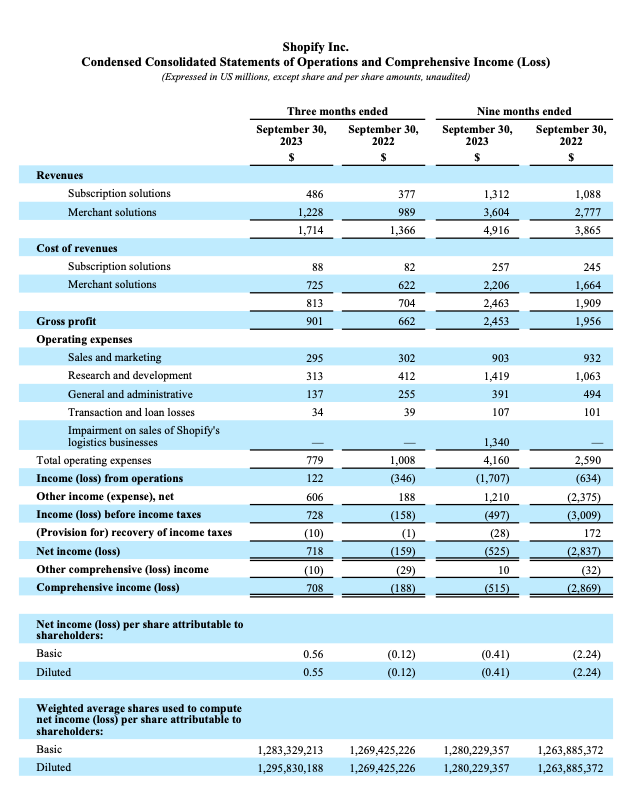
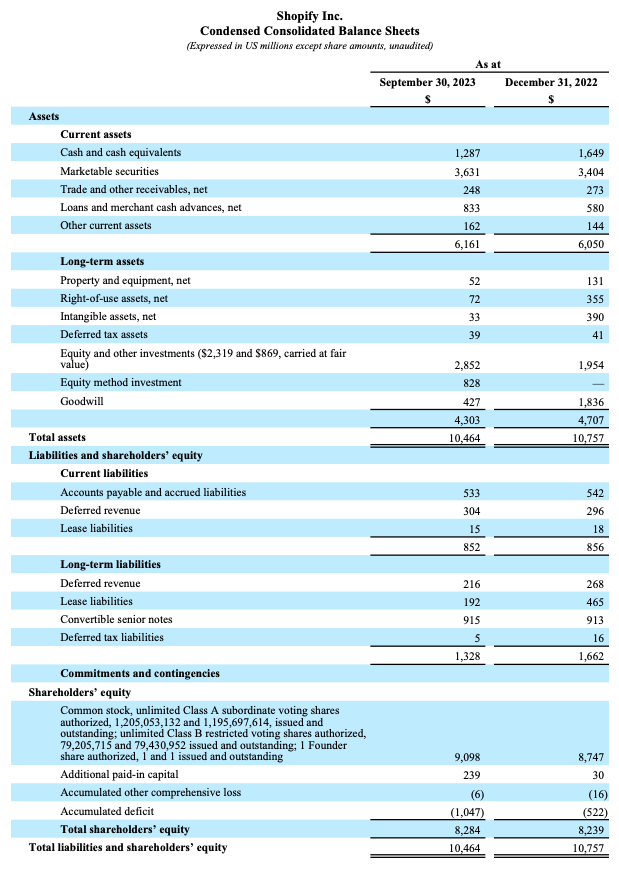
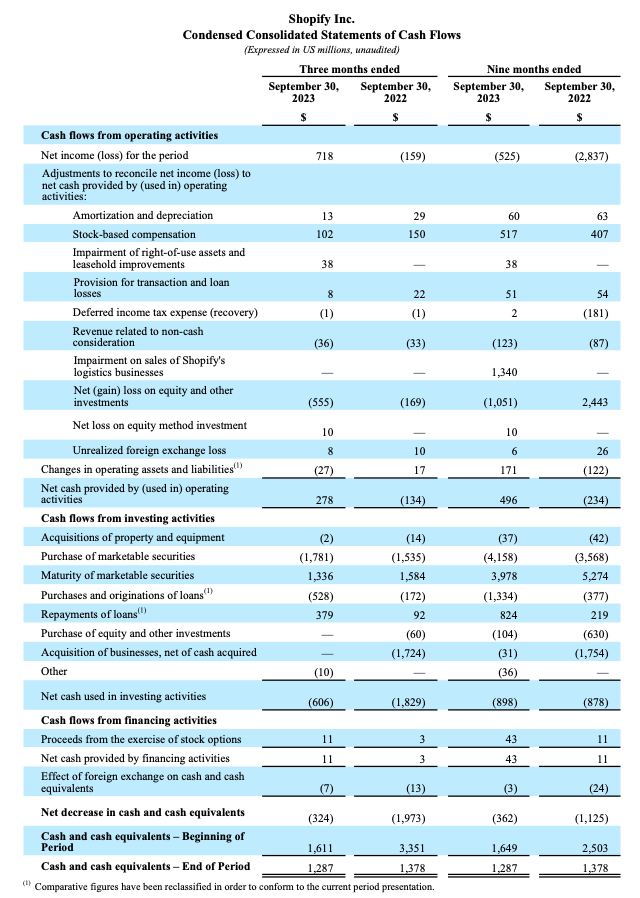
Non-GAAP and Other Financial Measures
To supplement our consolidated financial statements, which are prepared and presented in accordance with United States generally accepted accounting principles (“GAAP”), Shopify uses certain non-GAAP and other financial measures to provide additional information in order to assist investors in understanding our financial and operating performance. These measures are not recognized measures for financial presentation under U.S. GAAP, do not have standardized meanings, and may not be comparable to similar measures presented by other public companies.
Adjusted gross profit, adjusted sales and marketing, adjusted research and development, adjusted general and administrative expenses, adjusted impairment on sales of Shopify’s logistics businesses, adjusted operating income/loss, adjusted net income/loss and adjusted net income/loss per share are non-GAAP financial measures that exclude the effect of stock-based compensation expenses and related payroll taxes, accelerated stock-based compensation, amortization of acquired intangibles, severance related costs, provisions associated with litigation-related accruals, real estate-related impairment charges, and impairment on sales of Shopify’s logistics businesses. Adjusted net income/loss and adjusted net income/loss per share also exclude unrealized and realized gains and losses on equity and other investments, net loss on equity method investment, and tax effects related to non-GAAP adjustments. Free cash flow is a non-GAAP financial measure calculated as cash flow from operations less capital expenditures. Free cash flow margin is a non-GAAP ratio calculated as free cash flow divided by revenue. Shopify considers free cash flow and free cash flow margin as indicators of the efficiency and liquidity of Shopify’s business, showing cash available after capital expenditures, to make strategic investments and drive future growth.
Management uses non-GAAP and other financial measures internally for financial and operational decision-making and as a means to evaluate period-to-period comparisons. Shopify believes that these non-GAAP measures provide useful information about operating results, enhance the overall understanding of past financial performance and future prospects, and allow for greater transparency with respect to key metrics used by management in its financial and operational decision making. The non-GAAP and other financial measures used herein be considered as a supplement to, and not a substitute for, or superior to, the corresponding measures calculated in accordance with GAAP. See the financial tables below for a reconciliation of the non-GAAP measures.
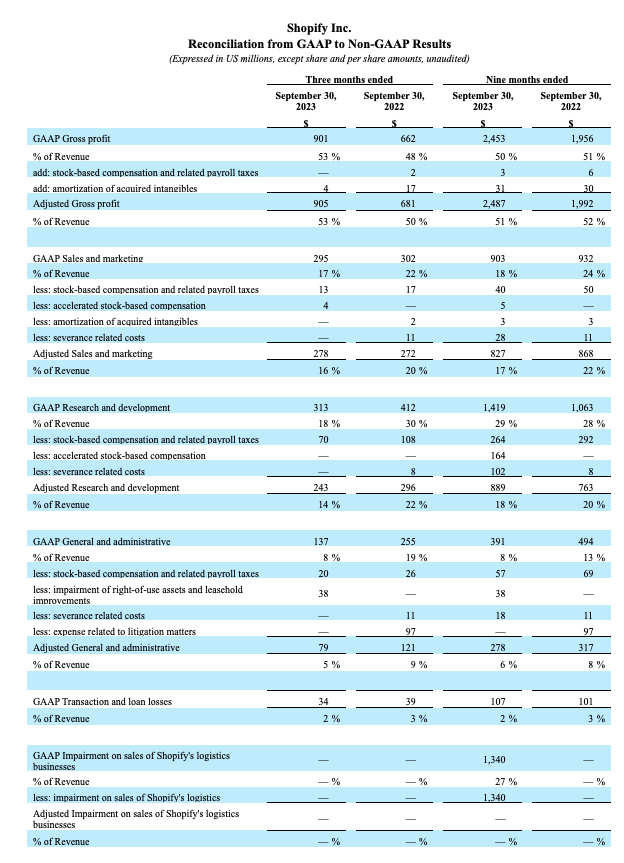
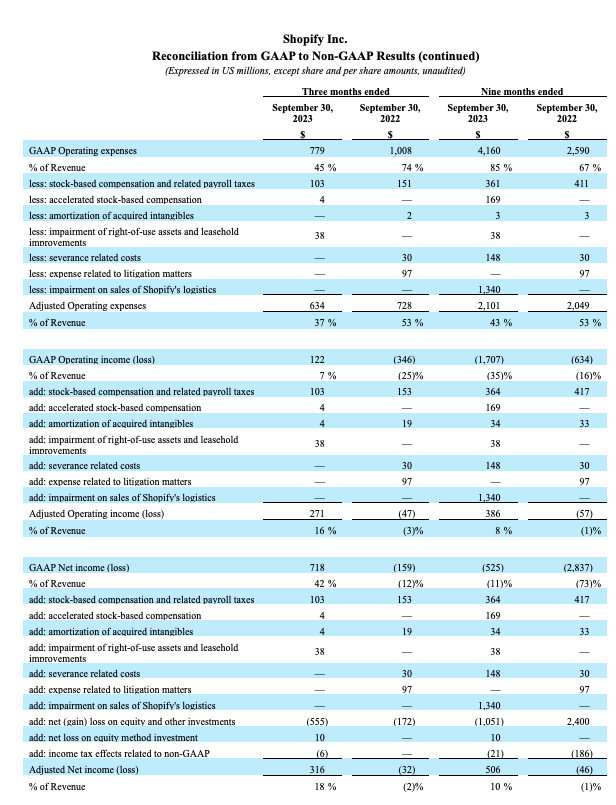
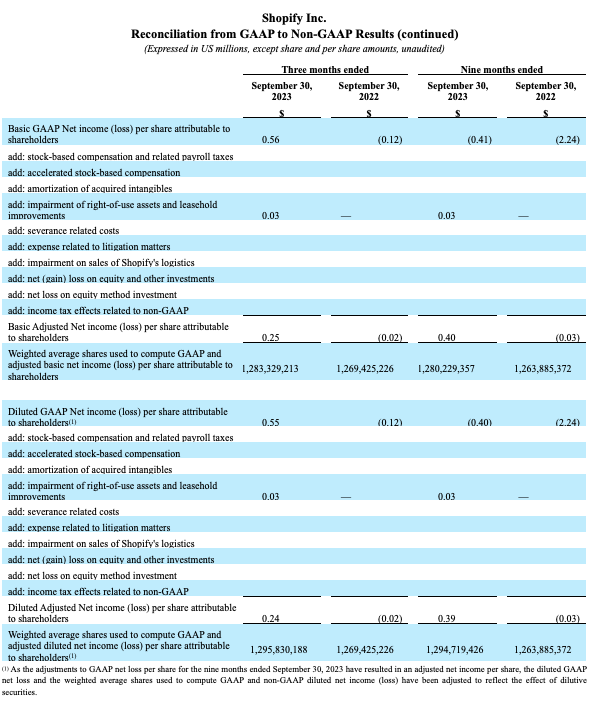
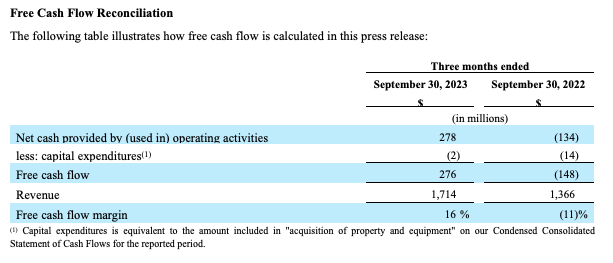
Financial Performance Constant Currency Analysis
The following table converts our GMV, revenues, gross profit and (loss) income from operations using the comparative period’s monthly average exchange rates. The table below setting out the effect of foreign exchange rates on GMV and our consolidated statements of operations disclosure is a supplement to our consolidated financial statements, which are prepared and presented in accordance with U.S. GAAP. We have provided the below disclosure as we believe it presents a clear comparison of our period to period operating results by removing the impact of fluctuations in foreign exchange rates and to assist investors in understanding our financial and operating performance. Adjusted gross profit and adjusted operating income/loss are not recognized measures for financial statement presentation under U.S. GAAP, do not have standardized meanings, and may not be comparable to similar measures presented by other public companies. Such non-GAAP financial measures should be considered as a supplement to, and not as a substitute for, or superior to, the corresponding measures calculated in accordance with U.S. GAAP.
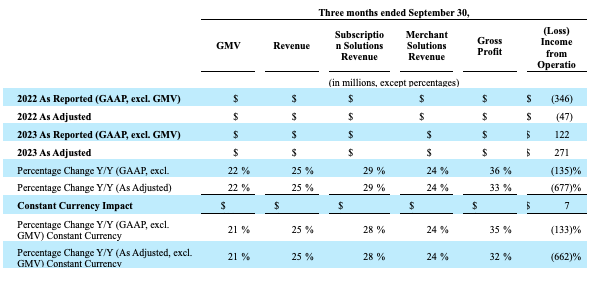
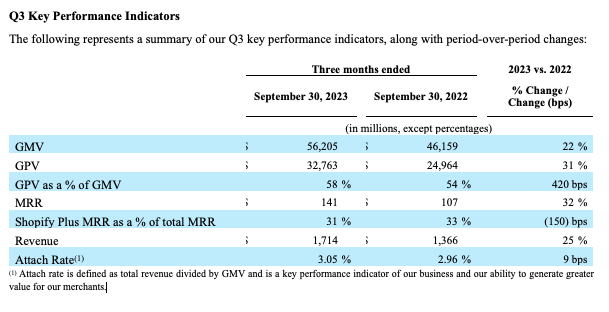
1. Gross Merchandise Volume, or GMV, represents the total dollar value of orders facilitated through the Shopify platform including certain apps and channels for which a revenue-sharing arrangement is in place in the period, net of refunds, and inclusive of shipping and handling, duty and value-added taxes.
2. Gross Payments Volume, or GPV, is the amount of GMV processed through Shopify Payments.
3. Monthly Recurring Revenue, or MRR, is calculated by multiplying the number of merchants by the average monthly subscription plan fee in effect on the last day of that period and is used by management as a directional indicator of subscription solutions revenue going forward assuming merchants maintain their subscription plan the following month.
4. Free Cash Flow and Free Cash Flow Margin are non-GAAP financial measures. Please refer to “Non-GAAP and Other Financial Measures” below for more information.
5. Capital expenditures is equivalent to the amount included in Acquisition of property and equipment on our Consolidated Statement of Cash Flows for the reported period.











